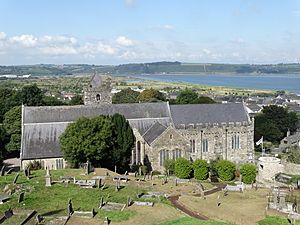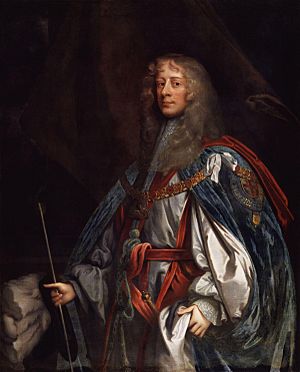Michael Jones (soldier) facts for kids
Quick facts for kids
Michael Jones
|
|
|---|---|

St Mary's, Youghal, where Jones was buried
|
|
| Governor of Dublin | |
| In office 1647–1649 |
|
| Governor of Chester | |
| In office 1646–1647 |
|
| Personal details | |
| Born | Between 1606 and 1610 Ardagh, County Longford |
| Died | 10 December 1649 (aged 42–43) Dungarven, County Wexford |
| Spouse | Mary Culme (1646–his death) |
| Relations | Lewis Jones, Bishop of Killaloe (1542–1646) |
| Military service | |
| Years of service | 1641–1649 |
| Rank | Lieutenant-General |
| Unit | Jones' Regiment of Horse |
| Commands | Military commander, Leinster |
| Battles/wars | |
Lieutenant-General Michael Jones was an important soldier born in Ireland, who lived from about 1606 to 1649. He came from a Welsh family. He fought for the Parliament (also called the "Roundheads") during the War of the Three Kingdoms. This was a big conflict that involved England, Scotland, and Ireland. Michael Jones mostly fought in Ireland.
His father, Lewis Jones, was a bishop, which is a high-ranking church leader. Michael's brothers, Henry and Ambrose, also became bishops in the Protestant Church of Ireland.
When the Irish Rebellion of 1641 started, Michael Jones first fought for the Protestant government in Dublin. But later, he disagreed with a peace deal made in 1643. Because of this, he switched sides in 1644 and joined the Parliament's army in England. He stayed there until the end of the First English Civil War in 1646.
In 1647, he became the governor of Dublin and a military leader in Leinster, a region in Ireland. He won major battles against the Royalist (King's supporters) and Irish Confederate armies at Dungan's Hill and Rathmines. In 1649, Oliver Cromwell, a famous Parliamentarian leader, arrived in Ireland. Jones then served under Cromwell at the sieges of Drogheda and Wexford.
The Parliamentarian army then tried to capture Waterford, but many soldiers got sick. They had to retreat. Michael Jones died of a fever on December 10, 1649. Cromwell wrote to Parliament, saying that England had lost a great leader.
Contents
Early Life and Family
Michael Jones was born in Ardagh, County Longford, Ireland, between 1606 and 1610. He was the third of five sons. His father, Lewis Jones, was a Welshman who became the Bishop of Killaloe in 1633.
Michael's uncle, James Usher, was the head of the Church of Ireland for many years. Two of Michael's brothers, Henry and Ambrose, also became bishops. His other two brothers, Oliver and Theophilus, were also soldiers and politicians.
In 1646, Michael married Mary Culme. They did not have any children. He left his belongings to his nephew, also named Michael, who was his brother Henry's son.
Starting His Military Career
In 1631, Michael Jones went to Lincoln's Inn in London to study law. He later joined King's Inns in Dublin in 1640 and started working as a lawyer.
When the Irish Rebellion of 1641 began, he joined the King's army to stop it. He fought under the Earl of Ormonde, who was loyal to King Charles I. Jones quickly became known as a skilled leader of cavalry (soldiers on horseback).
However, the First English Civil War started in England in 1642. This meant Ormonde could not get more soldiers or money from England. By 1643, the Catholic Confederacy controlled most of Ireland, except for a few cities like Dublin.

King Charles I wanted to use his Irish soldiers to help him win the war in England. So, in 1643, Ormonde made a truce, or "Cessation," with the Confederacy. Many people on both sides did not like this truce. Protestants felt it threatened their safety, and many Confederates felt they were close to winning and gained nothing.
Michael Jones, who was a Major at this time, was chosen to share the Protestant views. But when he found out that Ormonde was sending 6,000 Irish troops to help the King in England, he changed his mind. He left the King's side and joined the Parliamentarian forces in England. He believed that only a Parliament victory could protect the Church of Ireland.
Fighting in England
For the next two years, Jones helped block the city of Chester, which was important to the Royalists. He led raids, showing how tough the fighting was. For example, in 1645, he led a group that took livestock and fought with people defending their property.
In September 1645, he fought in the Battle of Rowton Heath, where Parliament won a big victory. He also stopped enemy forces from reaching Chester at Denbigh Green in November. When Chester finally surrendered in February 1646, Jones was made its Governor.
After this, Jones was transferred back to Ireland.
Leading in Ireland
In 1646, Parliament chose Michael Jones to be a military commander in Ireland. But he couldn't start right away because Ormonde still controlled Dublin for King Charles I. The Parliament's navy blocked trade to Dublin, which forced Ormonde to make a deal in 1647.
Jones became Governor of Dublin on June 6, 1647, arriving with 2,000 soldiers. He quickly put new rules in place, like removing Catholics and arresting Royalist Protestants. Ormonde himself was sent away in July.
In August, Jones left Dublin with about 4,800 soldiers to help Trim, which was under attack by a Confederate army. As he got closer, the enemy army left. On August 8, Jones won a huge victory at the Battle of Dungans Hill. More than half of the enemy army was killed or captured, and the Confederates lost control of the Leinster region.
The Second English Civil War started in 1648, which stopped Jones from fully using his success. Even though the King's side was losing in England and Scotland, King Charles still hoped to get his throne back with help from Ireland. In 1649, Ormonde and the Confederates signed a treaty. After King Charles was executed, other groups joined this alliance.
However, this alliance was not fully united. Jones sent his older brother Henry to make a truce with one of the Irish Catholic groups.
By May 1649, the Royalist and Confederate alliance controlled most of Ireland. After capturing Drogheda and Dundalk in June, Ormonde moved towards Dublin. He wanted to stop Cromwell's army from landing there. On July 22, Ormonde arrived outside Dublin with 11,000 men. Four days later, Jones got more soldiers, bringing his total to about 5,200. Even though he had fewer soldiers, Jones's troops were experienced. On August 2, Jones defeated Ormonde at the Battle of Rathmines. This was a very important victory.
Jones then tried to capture Drogheda, but he didn't have enough soldiers. He returned to Dublin, where Oliver Cromwell landed on August 15 with 12,000 troops. Cromwell made Jones a Lieutenant-General of the cavalry. Jones then helped Cromwell capture Drogheda and Wexford.
Jones became sick during the unsuccessful Siege of Waterford in November. He was taken to Dungarvan, where he died on December 10, 1649. Cromwell wrote to Parliament, saying, "What England lost hereby is above me to speak," showing how much he valued Jones.
Michael Jones was buried in the Boyle family tomb at St. Mary's Church in Youghal. Cromwell gave a speech at his funeral. There is a plaque on the house in Dungarvan where he died, remembering him.
Sources
- Clarke, Aidan (2004). "Jones, Michael". Oxford Dictionary of National Biography (online). Oxford University Press. DOI:10.1093/ref:odnb/15063. (subscription or UK public library membership required)

